|
|
 |
 |
 |
 |
| Emtac Mini S3 Bluetooth GPS receiver review |
Date 19th June 2007
|
Review by Mike Barrett
The first Bluetooth GPS receiver that I reviewed was the original Emtac Bluetooth GPS way back in 2002. At the time this was the first Bluetooth GPS and it stood the test of time. Transplant introduced this GPS receiver in the USA.
Over the years the Emtac brand has changed hands and is now distributed worldwide by Transplant. In that time a number of BT GPS receivers have been released. The most recent and the subject of this review is the Emtac Mini S3 Bluetooth Receiver.
The Emtac mini-S3 is the smallest of the Emtac Bluetooth GPS receivers to date, but does its size affect it's performance?
Whats in the box
The Emtac mini-S3 package comes complete with the following items:
- The Emtac mini-S3 GPS receiver
- A mains power supply
- A car cigar lighter power supply
- Instruction manual CD
|

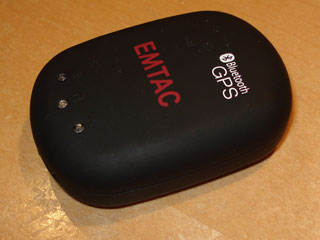
|
Specifications
The following specifications are taken from the official Emtac documentation:
Chipset: SiRF Star III
General:
Frequency: L1, 1575.42 MHz
C/A: 1.023 MHz chip rate
Channels: 20 channel all-in-view tracking
DGPS Source Default: none
Programmable: WAAS/EGNOS
System Back Up: Built-in Li-Ion rechargeable battery
Antenna Type: Built-in
Accuracy
DPGS: 1-2 meters
Position: 1-5 meters CEP, without SA
Velocity: 0.1 meters/second, without SA
Time: 1 microsecond synchronized to GPS time
Datum: WGS-84 (or by demand)
Acquisition Rate: open sky, stationary
Reacquisition: 0.1 second, average
Cold Start: < 30 seconds, average
Warm Start: < 2 seconds, average
Hot Start: < 1 second, average
Dynamic Conditions:
Altitude: < 18,000 meters
Velocity : < 763 meters/second
Acceleration: < 4g
Interface:
Connection: Communicate with Host Platform via Bluetooth (Class 2) Serial Profile
Protocol Default: NMEA-0183 (v3.1.1) – GGA (1), GSA(1), GVS(5), RMC(1), VTG(1)
Programmable: Additional NMEA –VTG, GLL/SiRF Binary
Power: Built-in rechargeable battery & 5V DC input charging circuit
Operation Time Default: 8 hours (min.) after fully charged, in continuous mode
Programmable: >8 hours *Depends on duty cycle setting in trickle power
mode
Device Size: 68 (L) x 48 (w) x 18(H) mm
Environmental:
Operating Temperature: -20° C to +60° C
Relative Humidity: 5% to 95%,non-condensing |
|
The Emtac mini-S3 review
The Emtac mini-S3 is as it suggests a very small GPS receiver. It is not the smallest I have seen, but it is certainly among the smallest of the "conventional" Bluetooth GPS receivers.
To a certain extent the size of the device is limited by a number of physical factors, the main ones being the battery and the antenna. Granted you can get batteries of all different shapes and sizes, but you still need a reasonable sized power source.
|
|
The size of the patch antenna is not supplied, but I would expect it to be 25mm. This results in the size of the complete package.
To the right you can see the bottom of the GPS receiver. I have had to over expose the picture so that you can see the features.
On the base are a power switch and the mini-usb power connector. The USB supplies power only, the GPS data are transferred over the bluetooth link.
On the front of the Emtac mini-s3 are 3 indicator LEDs: Bluetooth connection, Power, and Satellite status. Unfortunately as with all these devices these LEDs flash rather than stay lit. |
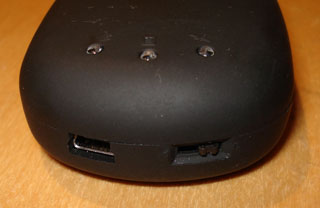 |
At the top of the Emtac GPS there is a loop attachment for a lanyard. With this you can hang the GPS receiver around your neck.
One of the style features I like about the GPS is the finish. It is a rubberised matt black. This soft feel looks great, but I was a little concerned that it may damage over time in use. As you can see from the pictures it has picked up a few marks and scratches. They are not as bad as they appear in the pictures as I had to over expose them to show the detail (as much as I love black it is a real problem to photograph the detail well). I would also point out that I have been deliberately giving the Emtac mini-s3 some rough treatment specifically to see how it scuffs up.
On the back of the Emtac mini-s3 is a removable cover housing the replaceable battery. Normally to achieve miniturisation a compromise has to be made, and the easiest component to make smaller is the battery, but at the expense of operating time.
The power source is a 700mAh Li-on battery, which despite it's size lives up to the claimed running time of 8 hours. Our battery life tests test the continuous operation of the GPS in a static environment with a good view of the sky. The Emtac mini-s3 averaged just under 8 hours over 4 full charge/discharge tests.
|
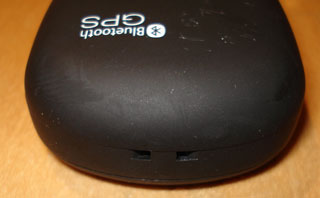
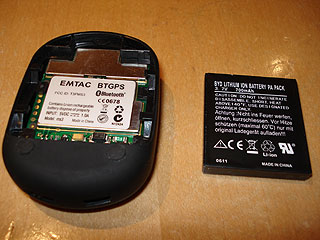 |
The Emtac mini-S3 Bluetooth GPS in use
Well the proof of the pudding is in the eating, and the only way to test a GPS is to get out in different environments and use it.
I paired my mini-s3 receiver with a number of PDAs, my Nokia N80, my Apple MacBook, and a Sony UX portable PC. In all cases I had no problems pairing and then connecting/disconnecting.
The start from cold was always very good. In almost all cases the GPS was fixed before I was ready to drive. Using it in cities where you expect to have problems with tall buildings the GPS fixed and reported the position accurately, there were a few occasions when the position snapped to the next road, but this was no more prevalent than for other GPS receivers.
the review sample I tested was WAAS capable, and I enabled it using a software application. During the time I tested I did not see a Differential Fix indicating that the accuracy was improved. This is not unusual as the DGPS satellites are notoriously difficult to pick up near where I live. Not that it really matters as the accuracy of the receiver is good for non-assisted positioning.
I took the GPS with me when we went to Taiwan for Computex, and as usual it picked up a fix (after moving 7000 miles) within a minute, and I had some beta maps of Taiwan on my Nokia phone and was able to help the locals navigate through Taipei.
|
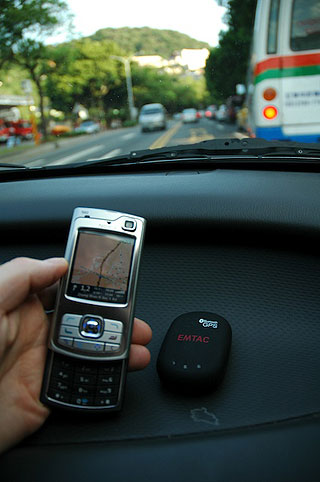 |
The size of the Emtac GPS is just about right. When you put it in your pocket it is light enough that you dont notice it, but it is big enough not to get lost in a bag or case. The battery life is also ideal for me: one day's traveling and then a charge overnight. It is all very well with some of the new GPS receivers having a 32 hour battery life, but I forget to charge those receivers overnight and they are guaranteed to go flat just when you really need them.
Conclusion
Emtac have once again produced a good performing Bluetooth GPS. It is interesting looking at the pricing of these devices and then comparing them with the original Emtac Bluetooth GPS. The Emtac mini-S3 retails at around £70 whereas the original Emtac Bluetooth GPS was £270...
If the specifications of the mini-S3 suit your requirements then I would have not problem in recommending this device. I think it ticks the boxes for style, function and price point a good all round GPS receiver. |
|
|
|
 |
 |
 |
 |
|
|